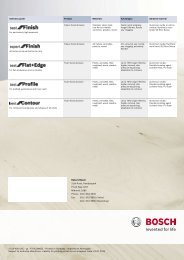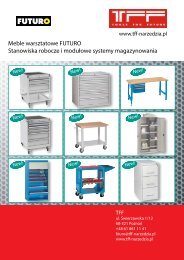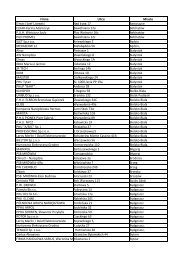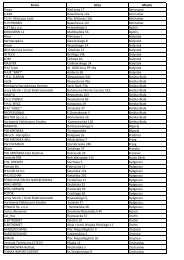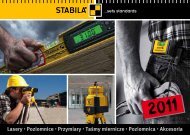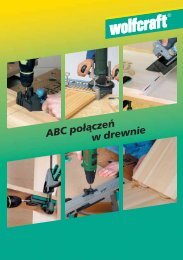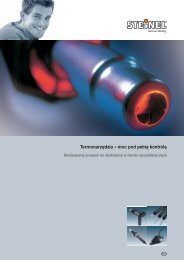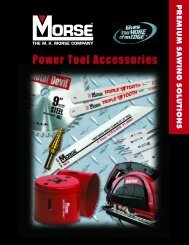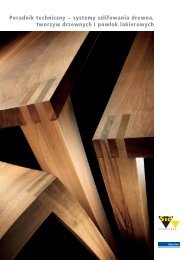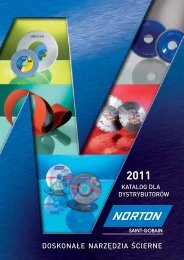RENNSTEIG Striking Tools - portalnarzedzi.pl
RENNSTEIG Striking Tools - portalnarzedzi.pl
RENNSTEIG Striking Tools - portalnarzedzi.pl
Sie wollen auch ein ePaper? Erhöhen Sie die Reichweite Ihrer Titel.
YUMPU macht aus Druck-PDFs automatisch weboptimierte ePaper, die Google liebt.
��������������������������������<br />
<strong>RENNSTEIG</strong><br />
Schlagwerkzeuge<br />
Allgemeine Informationen<br />
Rennsteig Schlagwerkzeuge erfüllen in Form und Ausführung<br />
DIN-Normen. Aus Chrom-Vanadium-Lufthärtestahl werden<br />
Meißel, Körner, Durchtreiber und S<strong>pl</strong>intentreiber geschmiedet.<br />
Alle Schlagwerkzeuge werden durchgängig vergütet, garantieren<br />
somit hohe Standzeit und gute Elastizität (Belastbarkeit).<br />
Durch Schlagkopfvergütung nach DIN werden Auss<strong>pl</strong>itterungen<br />
und Wulstbildung nahezu vermieden. Kegel und Zylinderschäfte<br />
werden poliert. Das Meißelblatt der Handmeißel wird wahlweise<br />
poliert oder in der preisgünstigeren Ausführung lackiert angeboten.<br />
Der Schaft aller Schlagwerkzeuge ist lackiert.<br />
Arbeitssicherheit beim Umgang<br />
mit Handschlagwerkzeugen<br />
Durch die hohe Verletzungsgefahr beim unsachgemäßen<br />
Arbeiten mit Handschlagwerkzeugen sollten nachfolgend<br />
genannte Mindestanforderungen der Arbeitssicherheit unbedingt<br />
eingehalten werden.<br />
Grundsätzliches Tragen einer Schutzbrille<br />
Richtige Auswahl des Schlagwerkzeuges sowie der erforderlichen<br />
Hammergröße entsprechend dem Einsatzfall<br />
Vermeidung von Bearbeitungen gehärteter Materialien über<br />
40 HRC wegen Verletzungsgefahr durch Abs<strong>pl</strong>itterung<br />
Vermeidung von Öl- oder Fettverunreinigungen am<br />
Schlagkopf<br />
Gratbildung am Schlagkopf regelmäßig sauber verschleifen<br />
Vor Arbeitsbeginn unbedingte Sichtkontrolle des Arbeitsmittels,<br />
stark abgenutzte Arbeitsenden unbedingt<br />
nachschleifen<br />
Keinen zweckentfremdeten Einsatz von<br />
Schlagwerkzeugen vornehmen.<br />
Nachbehandlungsvorschrift<br />
für Handschlagwerkzeuge<br />
<strong>RENNSTEIG</strong> Handschlagwerkzeuge sind durchgängig vergütet.<br />
Eine Nachbehandlung des Arbeitsendes kann problemlos vorgenommen<br />
werden, wobei man nach dem Grad des Verschleißes<br />
am Arbeitsende unterscheidet in<br />
Nachschleifen<br />
bei geringer Abnutzung der Schneide<br />
- kurze Schleifintervalle<br />
- Vermeidung von zu hoher Schleifwärme und somit Vermeidung<br />
von Härteminderung und Schleifrissen<br />
- Unbedingte Wasserkühlung beim Nachschleifen<br />
Nachschmieden<br />
bei starker Abnutzung unter Beachtung nachfolgender<br />
� ������������<br />
Schmieden Erwärmung des Schmiedebereiches<br />
(Blatt + 30mm) auf Schmiedetemperatur<br />
950° bis 1050°C<br />
Härten entsprechend dem Einsatzmaterial Erwärmung<br />
auf Härtetemperatur (790° bis 880° C)<br />
und sofort Abschrecken in Abschrecköl<br />
Anlassen Erwärmung<br />
Anlaßtemperatur ca. 280° C<br />
Nach erfolgter Wärmebehandlung wird die Schneide<br />
nachgeschliffen.<br />
Das Nachschmieden und die anschließende Wärmebehandlung<br />
zu stark abgenutzter Arbeitsenden sollten von einem autorisierten<br />
Fachmann vorgenommen werden.<br />
��<br />
<strong>RENNSTEIG</strong><br />
<strong>Striking</strong> <strong>Tools</strong><br />
General Information<br />
All versions and styles of the <strong>RENNSTEIG</strong> striking tools com<strong>pl</strong>y<br />
with the DIN standards. Made of hardened chrome vanadium<br />
steel, the forged chisels and punches are quenched and<br />
tempered as a whole to guarantee a good resiliency and to<br />
resist hard working stress, thus offering a long service life.<br />
Owing to the hardened striking heads acc. to DIN standard, no<br />
s<strong>pl</strong>intering and “mushroom” heads will occur. The conical and<br />
parallel shanks of the punches are polished, chisel blades are<br />
offered with either polished or lacquered (reduced price) surface.<br />
Shanks of all striking tools are dip-coated.<br />
Health and safety regulations<br />
Due to high risk of being hurt by improper use of hand striking<br />
tools, all peo<strong>pl</strong>e involved should absolutely obey the following<br />
safety regulations.<br />
always wear safety goggles<br />
select the right striking tool and an appropriate<br />
hammer size for best possible ap<strong>pl</strong>ication<br />
avoid working on hardened material<br />
exceeding 40 HRC for danger of being seriously hurt<br />
by s<strong>pl</strong>intering<br />
avoid the striking head being soiled by lubricants<br />
do thoroughly grind away the burrs occuring on the<br />
striking head at regular intervals<br />
before working, check the cutting edge of the tool,<br />
work-worn cutting edges have to be reground<br />
do only use hand striking tools for what<br />
they are made for<br />
Instructions for aftertreatment<br />
As <strong>RENNSTEIG</strong> striking tools are quenched and tempered as<br />
a whole, repeated treatment of the cutting edge will be no problem<br />
in case the following is taken into consideration.<br />
�����������������������������������������<br />
regrinding<br />
(in case of lower wear and tear of cutting edge)<br />
- in short intervals<br />
- avoid excessive grinding heat in order to avoid<br />
as a consequence reduction of hardness and possible<br />
grinding cracks<br />
- ensure water cooling during regrinding process<br />
reforging<br />
(in case of heavy wear and tear of cutting edge)<br />
forging heating of the forging range<br />
(cutting edge + 30mm) up to a<br />
forging temperature of 950° to 1050°C<br />
hardening in accordance with the material used,<br />
heating up to hardening temperature<br />
(790° to 880°C) and immediate<br />
quenching in oil afterwards<br />
tempering heating up to tempering temperature<br />
of approx. 280° C<br />
After heat treatment the cutting edge has to be reground.<br />
Reforging and the subsequent heat treatment should only be<br />
done by trained and experienced peo<strong>pl</strong>e.



